Early Management, Board Members and City Officials
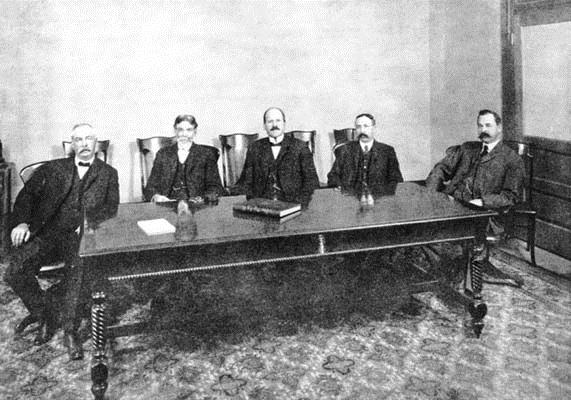 |
|
| (1902)* - The Board of Water Commissioners of the LA Department of Water and Power at the time of the building of the LA Aqueduct to Owens Valley. (L-R) John J. Fay, J. M. Elliott, Moses H. Sherman, William Mead, and Fred L. Baker. Sherman served on the water board while he also participated in plans to develop the San Fernando Valley, which became the outlet point for the aqueduct. Sherman's double role has been the source of conspiracy theories with regard to the aqueduct. |
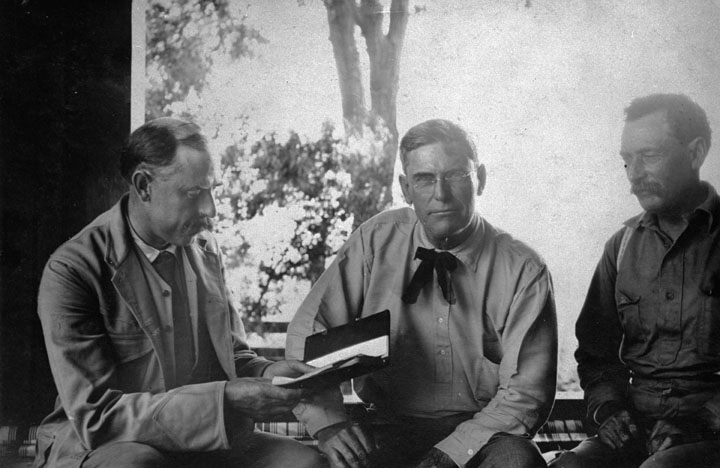 |
|
| (August 6, 1906)* - The three fathers of the LA Aqueduct - left to right: Joseph B. Lippincott, Fred Eaton and William Mulholland. This photograph appeared in the Los Angeles Times on August 6, 1906, less than a week after Lippincott's resignation from the Reclamation Service became effective. |
The Three Fathers of the LA Aqueduct: Click HERE to read more from the LADWP Historic Archive.
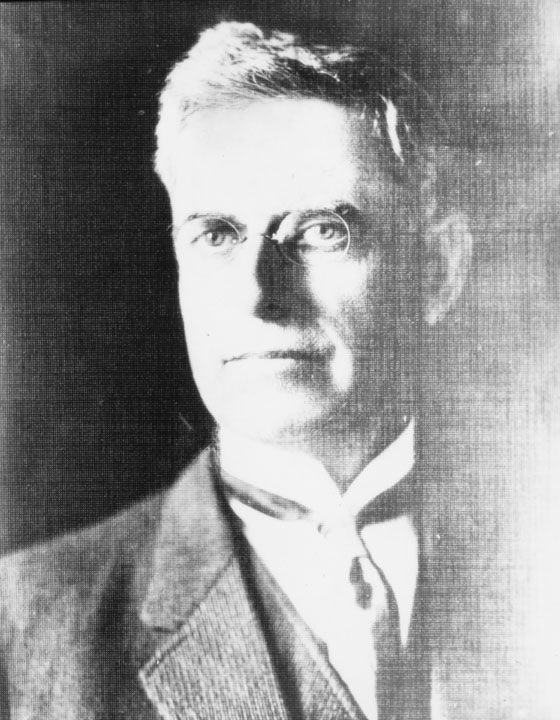 |
Frederick Eaton (1855-1934) - He began his apprenticeship with the Los Angeles City Water Company when he was fifteen. His native abilities led him to become general superintendent in 1875, five years later. On December 22, 1885 he was appointed to the unexpired term as city surveyor and engineer and was re-elected on December 6, 1886 to a second one-year term. He served as city engineer again in 1889-1890. He capped his city service with election to the office of mayor on December 5, 1898 for a single two-year term. Eaton’s more enduring contribution; however, lay in his knowledge of the Owens Valley country, a knowledge he acquired first hand. That knowledge was the seed which would eventually be harvested in the building of the Los Angeles Aqueduct. In that process Eaton played a controversial role in respect to land and water right acquisitions. *^ |
Click HERE for more on the connection between Fred Eaton and William Mulholland.
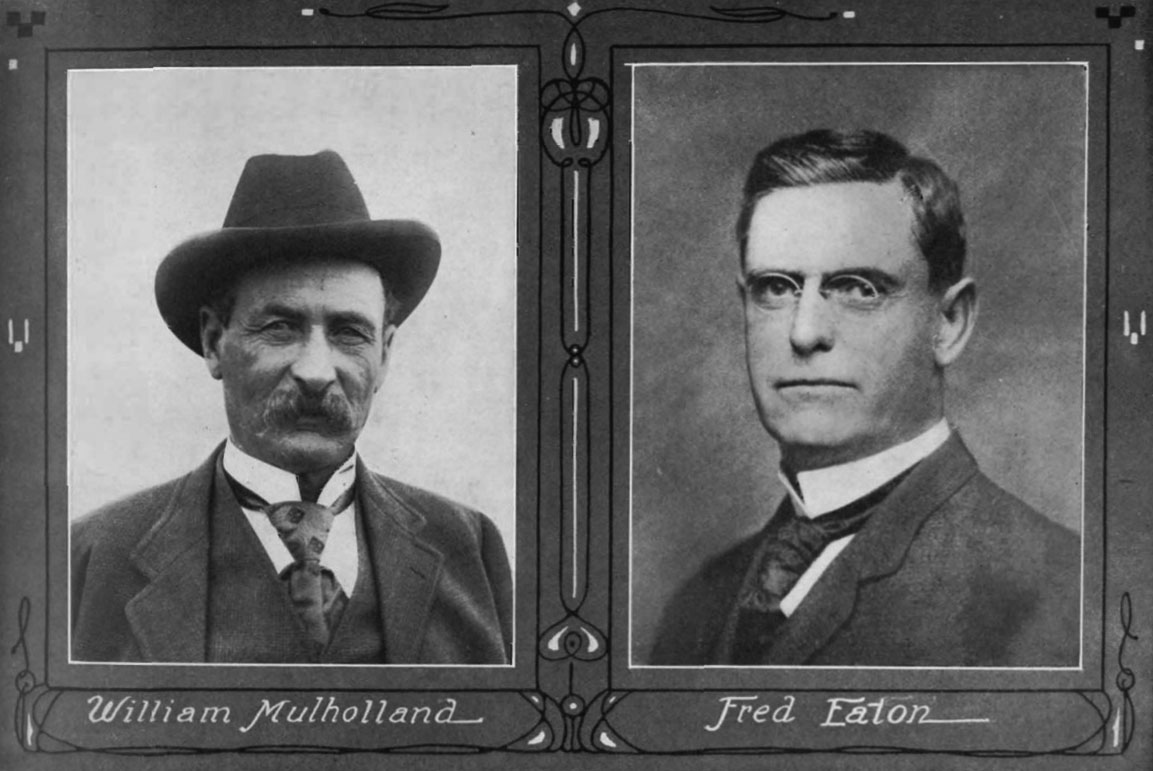 |
|
| (1913)*# – Portrait photographs of William Mulholland and Fred Eaton |
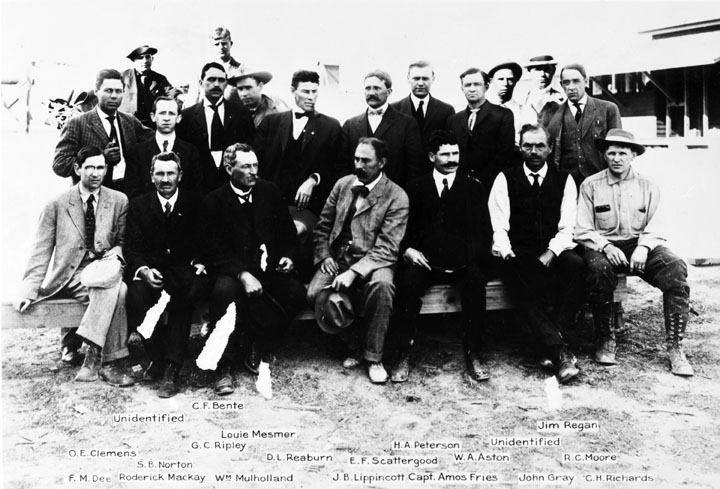 |
|
| (Early 1900s)* - William Mulholland and Staff |
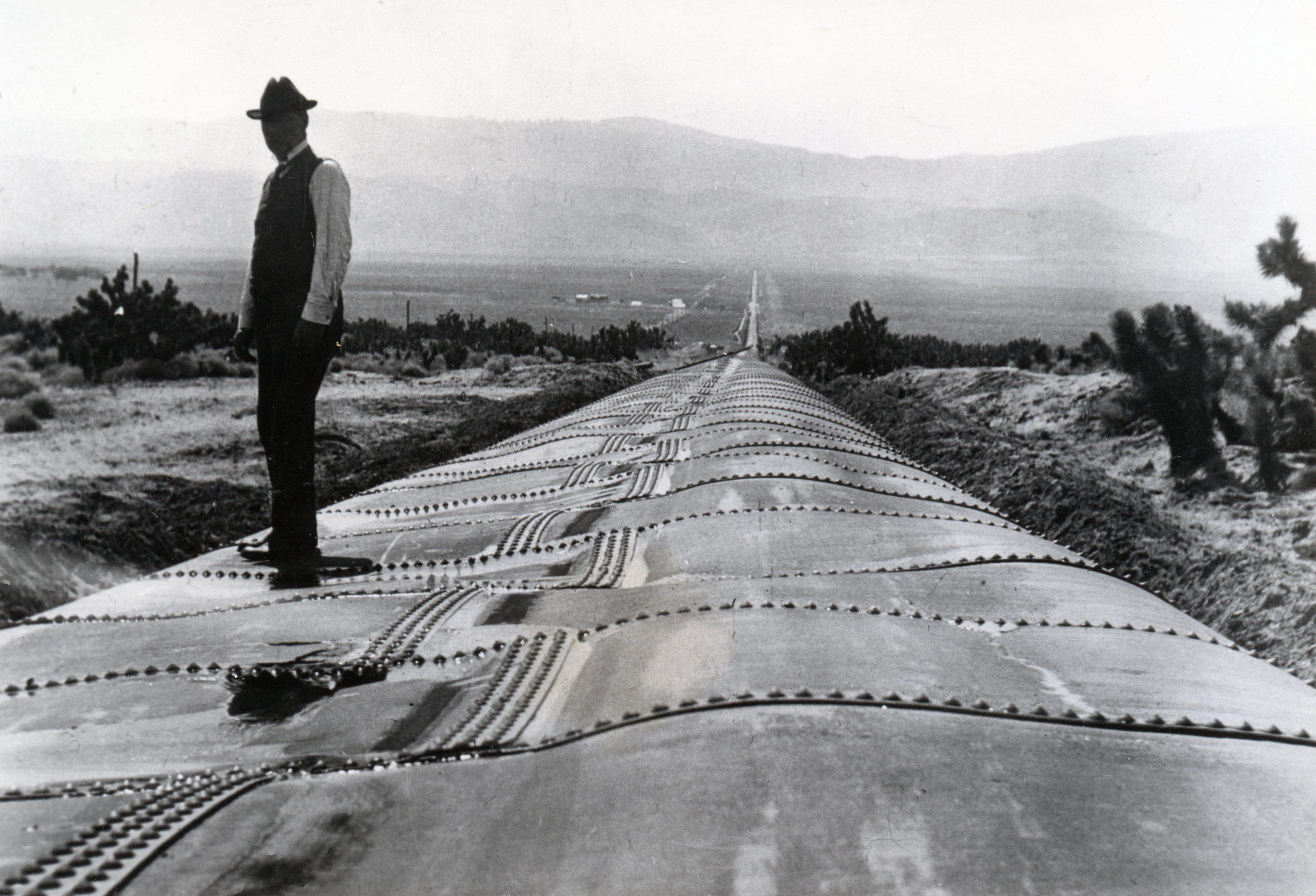 |
|
| (1914)*^ – View showing William Mulholland standing on a section of the Antelope Siphon damaged by a flood. Click HERE to see more in Construction of the Los Angeles Aqueduct. |
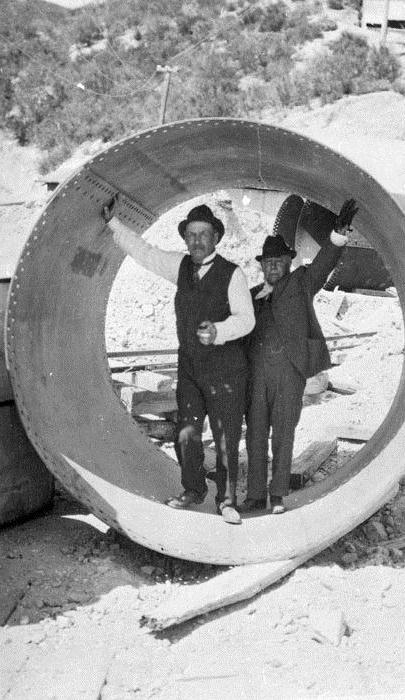 |
(ca. 1916)* - William Mulholland and Commissioner Del Valle in an 80" pipe at Power Plant 1 construction. Click HERE to see more in Electricity on the Aqueduct.
|
Historical Notes Reginaldo Francisco del Valle (December 15, 1854 - September 20, 1938) was a Californio statesman and lawyer, who served as a member of the California Senate and California Assembly. He was the youngest ever President pro tempore of the California Senate and was instrumental in the foundation of the institution today known as the University of California, Los Angeles. Del Valle served on the city Public Services Commission for twenty-one |
Board Commissioners (1902 - 1919)*
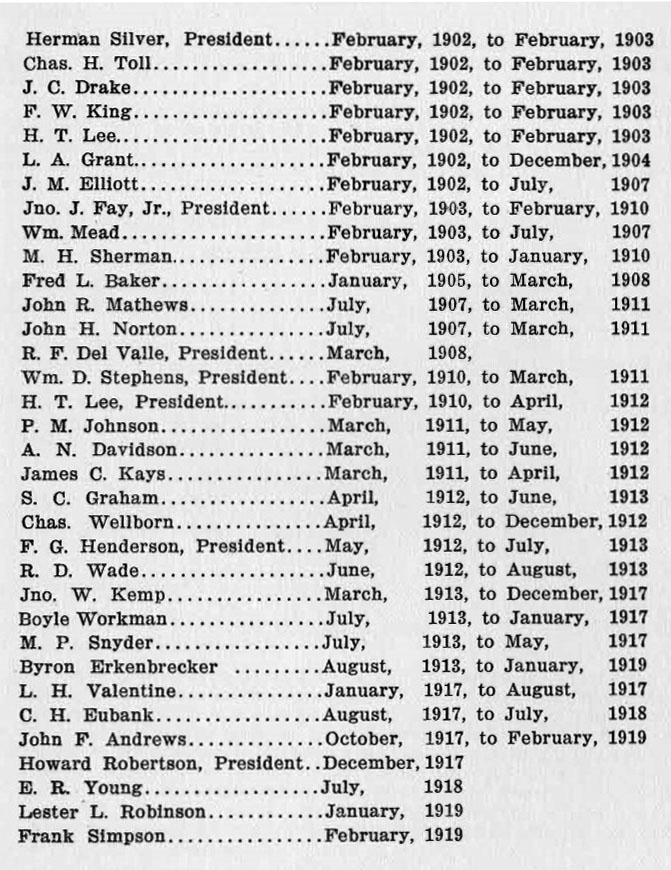 |
* * * * * |
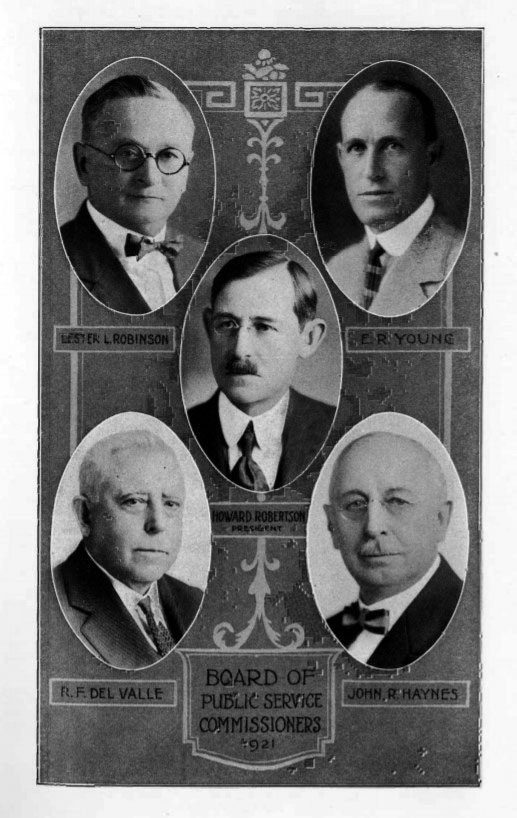 |
|
| (1921)* - Board of Public Service Commssioners: Howard Roberston, R. F. Del Valle, John R. Haynes, E. R. Young, and Lester L. Robinsion. |
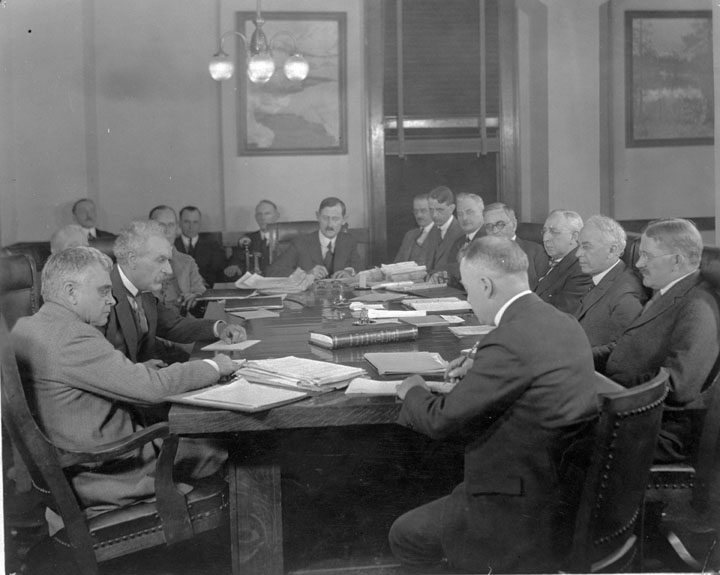 |
|
| (1920s)* - William Mulholland, Ezra Scattergood and Board members in meeting. |
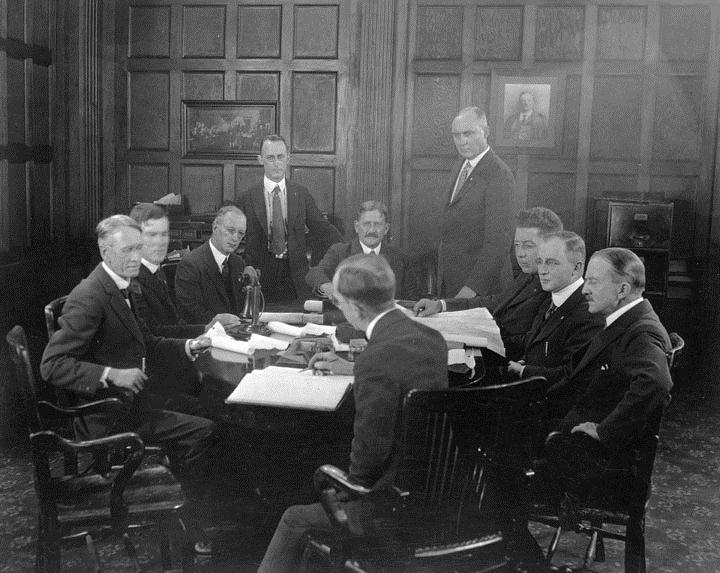 |
|
| (1920s)* - View showng Ezra Scattergood and staff. |
Historical Notes Ezra Scattergood moved to Los Angeles in 1902, spending several years as an electrical engineer. Four years later, he entered public service when the city retained him as a consulting engineer to plan and develop hydroelectric power for the construction of the Los Angeles Owens River Aqueduct. After studying plans for the aqueduct, Scattergood decided to place power plants at the end of a tunnel under Elizabeth Lake. The electric revenues from the plants helped pay for the tunnel and reduced construction costs of the aqueduct. In 1909, Scattergood was appointed the chief electrical engineer of the Bureau of Los Angeles Aqueduct Power. Two years later, voters approved a charter amendment that established a municipal power system called the Bureau of Power and Light, and Scattergood was again named chief electrical engineer. Under his supervision, hydroelectric plants were built along the Los Angeles Owens River Aqueduct. The success of these plants enabled the Bureau to buy out most of the private power companies in the city. The largest acquisition came in 1922, when the Bureau purchased the Southern California Edison’s distribution system in Los Angeles.*^ |
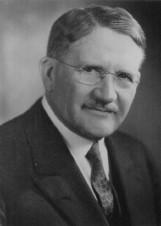 |
In 1920, Scattergood pushed for a bill authorizing the construction of the Boulder Canyon Project (Hoover Dam). Despite attempts to discredit the project, Scattergood helped convince Congress in 1928 to pass the legislation and allow construction of the dam and a hydroelectric power plant. He also negotiated a $23 million loan from the government to finance construction of the 266-mile Boulder Transmission Line, a giant undertaking that would bring electricity over deserts and mountains to Los Angeles. In 1936, the Boulder lines were completed and became the highest voltage long-distance transmission system in the world at that time. |
In 1937, the Bureau of Power and Light consolidated with the Bureau of Water Works and Supply and became the Department of Water and Power. The Department became the sole distributor of power in the city after purchasing the electrical system of the Los Angeles Gas and Electric Corporation. Scattergood remained at the helm of the Power System for 31 years. He was appointed to the National Power Policy Committee on Preparedness by President Franklin Delano Roosevelt and continued as chief electrical engineer until 1940.*^ |
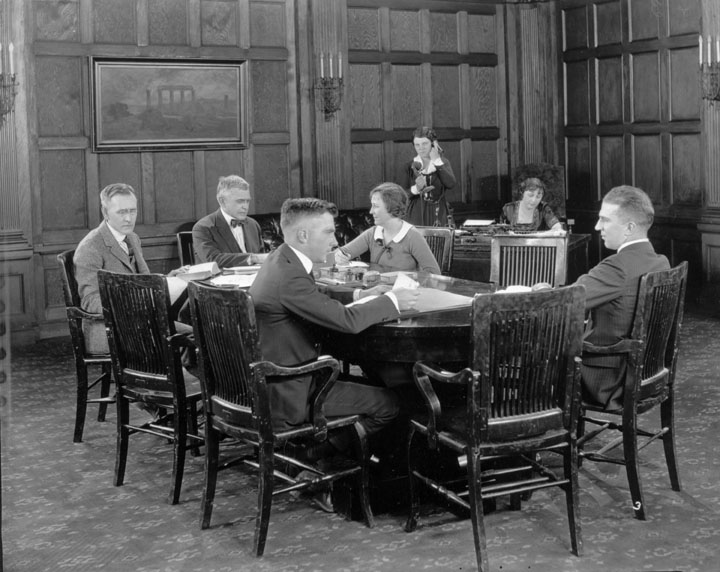 |
|
| (1920s)* - W. B. Mathews (second from left), head of Legal Division. |
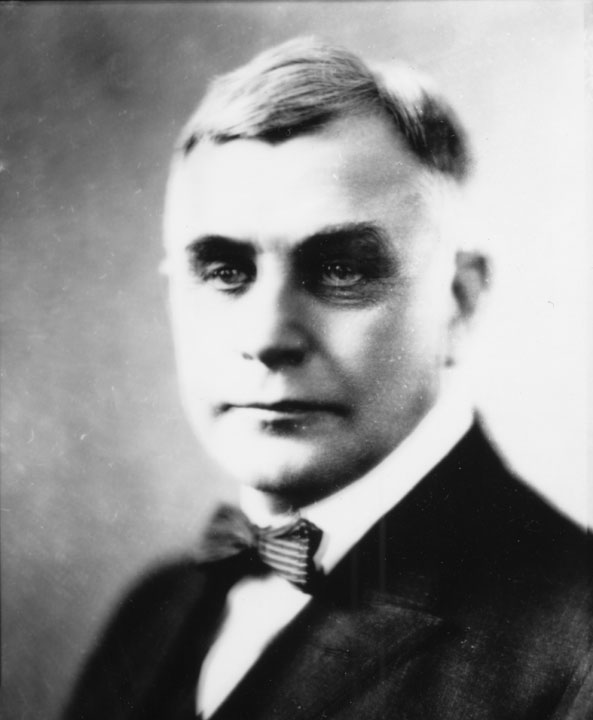 |
William Burgess Mathews (1865-1931) - In 1889 he settled in Los Angeles and opened a private practice. From 1898 to 1902 he was a member of the Board of Library Directors. He served as city attorney from 1900 to 1906 and was a member of the City Charter Revision Committee, 1906-1909. When he left the office of city attorney he entered a partnership styled Bordwee, Mathews & Wadsworth. He also served as special attorney for the Los Angeles City Water Department, advising them on legal and financial matters. His services place him in the front rank of those who wrought into permanent realities the Boulder Dam and Colorado River Aqueduct projects. A distinguished Lawyer and Public Servant…City Attorney for the City of Los Angeles, 1901-1907…Special Counsel for the Los Angeles Municipal Water and Power Systems, 1907-1929….General Counsel for the Metropolitan Water District of Southern California, 1929-1931. |
Mathews was memorialized in the name of Lake Mathews (previously the Cajalco Reservoir) in Riverside County, the western terminus for the Colorado River Aqueduct. It was dedicated to him in November 1940.*^ |
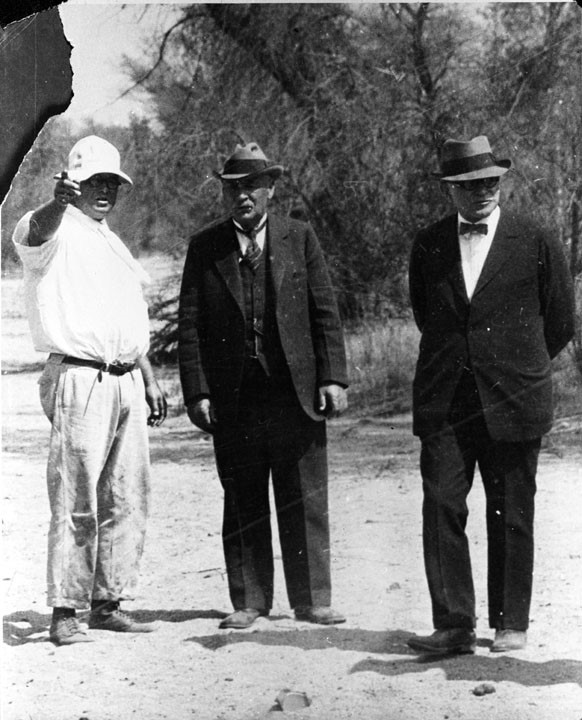 |
|
| William Mulholland (center) and William B. Mathews |
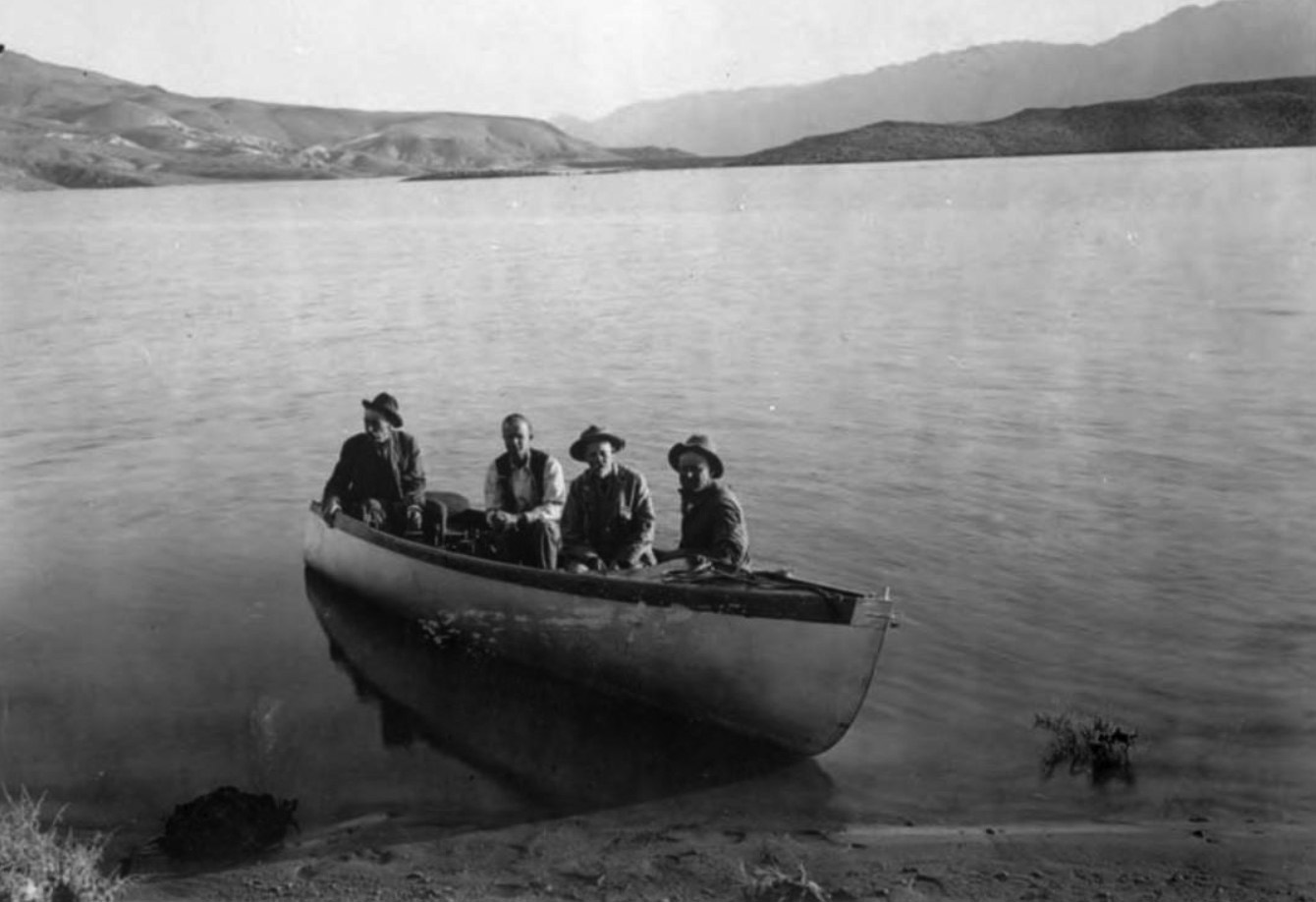 |
|
| William Mulholland in boat at Haiwee Reservoir.* |
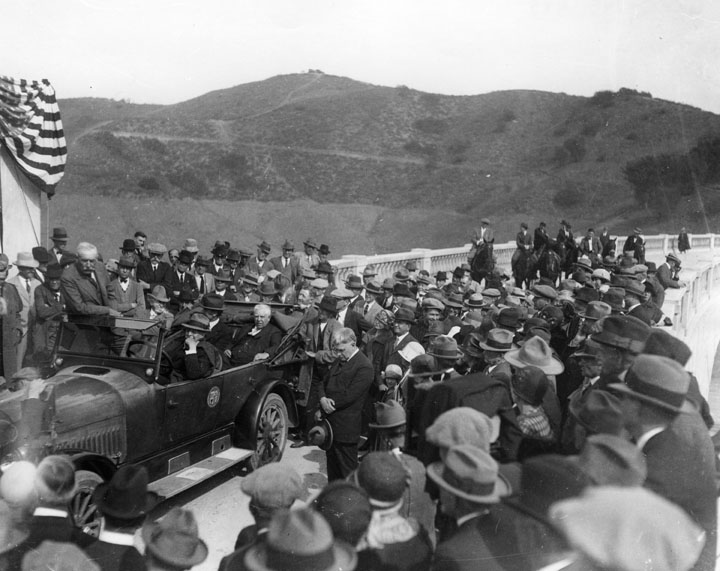 |
|
| (1925)* - William Mulholland is shown standing in the car at the Mulholland Dam and Hollywood Reservoir dedication. To the rear are several riders on horseback. Click HERE to see more of the Mulholland Dam and Hollywood Reservoir. |
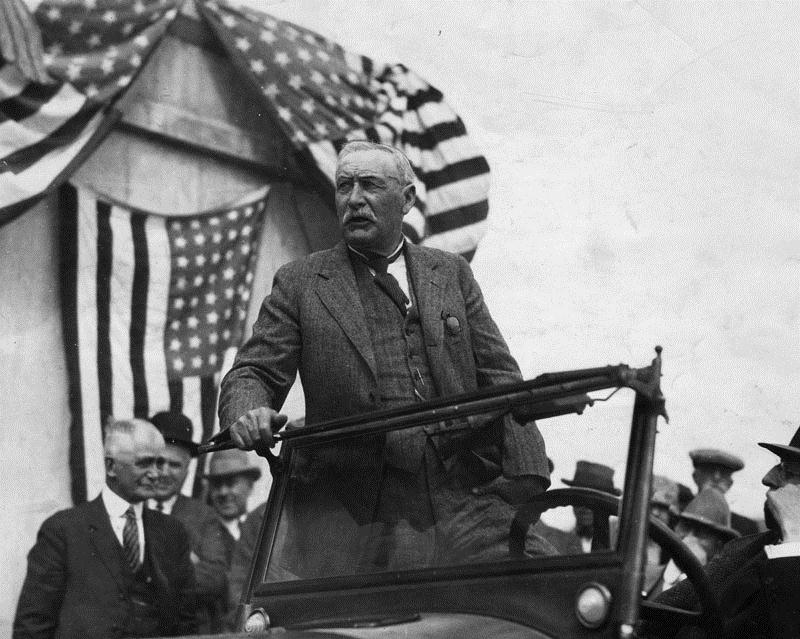 |
|
| (1925)* - Closer view of William Mulholland standing in an open automobile in front of American flags at the dedication of the Mulholland Dam and Hollywood Reservoir. Click HERE to see the William Mulholland Biography. |
 |
|
| (1925)^* - "The Party" about to embark for a trip through Boulder Canyon. They are assessing the potential sites for a dam on the Colorado River. William Mulholland can be seen at right. |
Historical Notes Members of a water resources consulting committee (F. E. Bonner, A. J. Cleary, G. A. Elliot, B. A. Etcheverry, F. C. Herrmann, Louis C. Hill, W. L. Huber, A. Kempkey, J. B. Lippincott, William Mulholland, and C.S. Ridley) prepare to embark on trip down the Colorado river, through Boulder Canyon, with representatives of the City of Los Angeles (William Mullholland, H. A. Van Norman, E. A. Bayley, H. C. Gardett, and S. Parratt) and the State of California (Paul Bailey and Gerald Jones). More than 200 engineers worked to design the dam that would be constructed in Black Canyon, Hoover Dam. It would be the highest concrete arch dam in the United States, and the largest building project that the federal government had ever undertaken. |
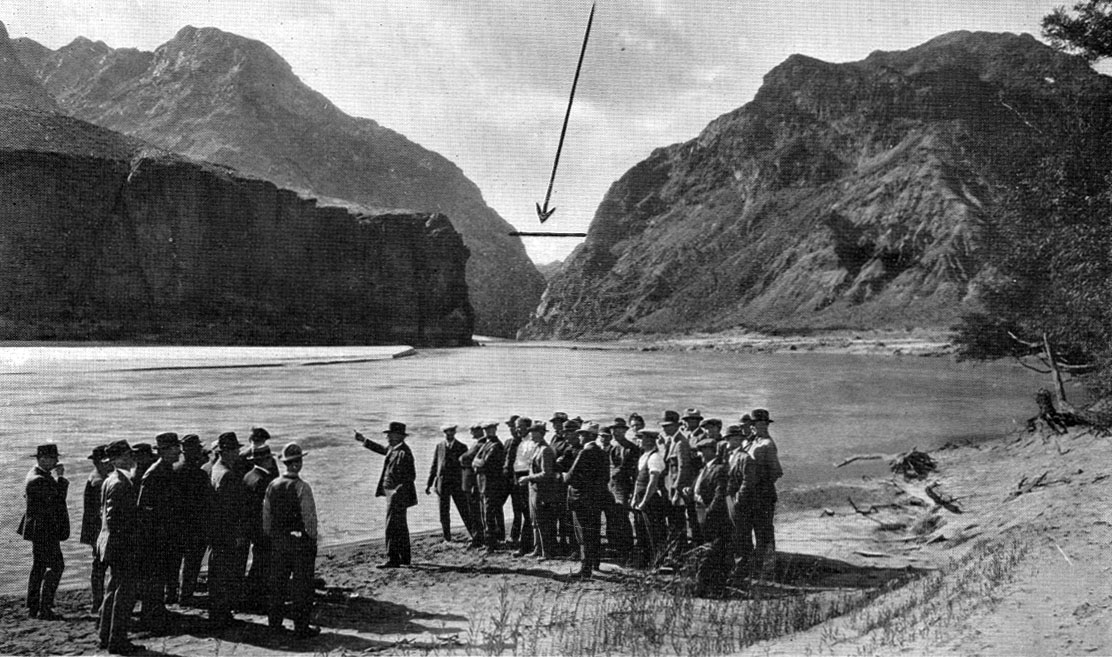 |
|
| (1925)*# - Chief Engineer William Mulholland of the Los Angeles Municipal Water Bureau (center) outlining to the party of Southern California officials the necessity and benefits of a high dam, during an inspection tour of the Colorado River. Arrow indicates Boulder Canyon Dam Site. |
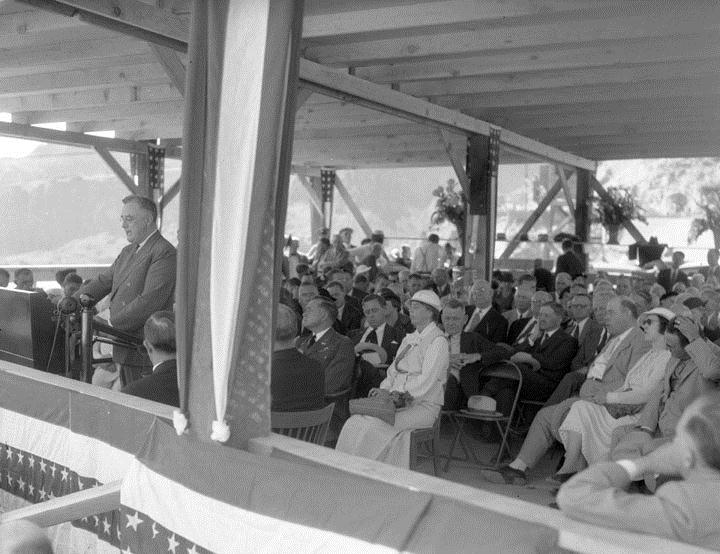 |
|
| (September 30, 1935)* - Dedication of Hoover Dam by President F. D. Roosevelt. Ezra Scattergood can be seen in the lower right behind the chair with the hat. |
Historical Notes In 1920, Ezra Scattergood pushed for a bill authorizing the construction of the Boulder Canyon Project (Hoover Dam). Despite attempts to discredit the project, Scattergood helped convince Congress in 1928 to pass the legislation and allow construction of the dam and a hydroelectric power plant.^# Click HERE to see more on the Construction of Hoover Dam. |
.jpg) |
|
| (1921)* - Department of Water and Power office workers and management. |
Historical Notes Movie stars for a day were these Department office employees when they appeared in a scene of the Department’s motion picture “Into The Future.” The photograph was taken on November 7, 1921, at the Brunton Studios. The film’s premiere showing was on August 15, 1922, at the Philharmonic Auditorium. Following list which names everyone in the picture, although not in the order given. John R. Haynes, William Mulholland, M. W. Buckingham, J. W. Bullas, E. C. Johnson, L. M. Anderson, Roy Chambers, Bob Bigler, W. C. Bieber, Ed Merritt, Ralph Durke, Ben F. Fletcher, Senator R. F. del Valle, George Yohn, Lily Gentz, W. S. Baird, R. R. Robertson, C. F. Yohn, H. H. Woehl, J. C. Albert, Ray E. Ballinger, Rose Butler, Pearl Webb, Eva H. Shoemaker, Mary Prange, Ray W. McCrea, Dr. Carl Wilson, A. R. Arledge, E. F. Scattergood, Bert W. Huff, W. B. Mathews, B. G. Warner, A. F. Ziegelmeyer, G. O. Dickens, Hilda Hoeller, Sigrid Lockwood, Carl V. Frisk, W. C. Haswell, Carrie Reider, Florence Hannibal, Marguerite Forest, Alberta Christie, Marion Pitman, Lenora B. Parshall, H. D. Baker. Eugenia Leete, John Grates, Kathryn Duffey, Mabel Montgomery, Mabel valentine, Jack Fanwick, C. E. Gazin, Ida Toffel, Lillian Veiner, Ida Schreiner, Sibyl Severence, Ruth Poling, Mamie Meek, Nellie Gunter, Joe Reider, Fred J. Fischer, H. A. Van Norman, W. W. Hurlbut, G. M. Beck, R. R. Proctor, Paul Langowsky, George Vejar, Goldie Mullin, May Lancaster, Al Powers, G. V. Wright, H. McCracken, Mrs. F. E. Crowfoot, Mina Bell, Mrs. Kathryn Hill, Katherine Shaefer, Mrs. Cora Neely, Edith Maile, Lynona Criswell, Edwin A. Auforth, Dick Faris, Billie Lipp, Mary Hawkins, J. F. Kenealy, W. H. Hoffman, John T. Martin, Alby Easton, Orpha Thompson, Anita Holt, Julie Rellar, Bertha Woodard, Stella Burnham. Mrs. Nell Gardner, Hazel L. Smith, Jeanette Forsythe, Margaret Hill, Elsie Osterberg, J. S. Millard, Joseph Scott, Floyd J. Allen, C. W. Suman, Charlie Gridley, Nellie Naylor, J. W. Wood, O. W. Holden, Justine Levy, F. W. McCabe, Harry Perrin, C. E. Outcalt, Gladys Moss, Lawrence Brady, John S. Dukes, Charles Neely, Emery Thacker, Ben F. Gilman, John Lavelle, Thad M. Erwin, W. W. Shrader, F. V. Gray, A. C. Cope, James P. Vroman, Sam Arthur, C. F. Stearns, E. H. Young, A. W. Elliott, S. B. Norton, Jake Steelman, Ted M. Wheeler, P. G. Slocum, Charles Needham, R. H. Thompson, E. S. Hawk, G. A. MacDonald, Robert Sheldon, Otto Whittaker, John F. Herlihy, F. C. Cady, C. S. Travis, Claude Hamilton. T. B. Russell, E. J. Sharp, Ralph Curtis, Charles H. Straub, George Read, W. H. Wyber, D. A. Lane, C. E. Angilly, E. A. Bayley, E. V. Kane, G. T. Gilmore, Howard Woodard, Billie Hughes, Eddie Rodden, J. B. Ashby, Jack White, J. S. Talcott, Jr., Wayne Harmon, C. J. Multhauf, Forest Hood, H. L. Browning, Norman Imbertson, S. L. Parratt, J. B. Dunlap, D. E. Rockfellow, W. S. Stamm, Bruce Phillips, Rogers Swire, Harry E. Wells, Harry Sullivan, W. T. Grover, H. Youngreen, G. W. Retzer, Sr., C. W. Parnell, Max Weiss, Clem Copeland, William Bailey, E. B. Mayer, J. E. Phillips, G. L. Killen, Roderick MacKay, Thomas Brooks, M. A. Phillips, A. C. Woodhouse, Walter Drayton, E. R. Burr, Dave Collins, F. H. Davies. George Moss, Shirley, L. Holt, J. J. Stigman, M. J. Fitz Gibbon, L. E. Moselle, Frank Harrington, S. K. Decker, O. Wingard, William J. Biddick, Lester L. Robinson, Leo W. Baker, Mike Millot, Bill McCauley, R. G. Burgess, R. P. Morrill, E. F. L. Nevin, F. G. Smithton, Frank McHugh, C. S. Billman, Walter B. DeNure, T. M. Mieding, C. E. Brown, W. R. Foster, Lester B. Clark, Clyde Erret, A. B. Craft, J. W. McIlvaine, S. P. Peterson, H. L. Bashford, Leslie Wright, D. J. Calderon, H. P. Bliss, Phil C. Scott, Earl Shipley, H. L. Swift, Frank Hines, Floyd Hinshaw, L. F. Nordhoff, Randolph George, Frank Keenan, P. W. Smith, George Fay, P. T. McIntyre, E. C. Cleaver, Lorenzo Anderson, Fred Bamborough, Martin J. Eichhorn. Paul Vincent, Wallace J. Fuller, J. H. Strigle, Anthony Lavelle, J. G. Francis, J. H. Westwater, Dan S. Parks, E. J. Sacket, E. J. Epman, Bill Mayes, J. Cardwell, Hugh M. Sanborn, Howard Warren, H. C. Simons, Perry Jackson, M. O. Bolser, S. A. Hayes, Charles Black, Fred Rotsel, P. B. Hardesty, J. Hunter Clark, C. A. Heinze, B. E. Landis, Dave Toffel, J. P. Sims, Burdett Moody, H. C. Gardett, Clarence Harbert, G. D. Pessell, R. F. Douglas, Roy Zoller, Henry Green, Trent Anderson, E. F. Glidden, N. S. Harshman, E. H. Osborn, Ed Leake, M. V. Windette, John Moran, E. B. Pierce, George Sopp, Sr., D. P. Nicklin, R. A. Zink, Charley Blake, George Hoffman, E. F. Fletcher, H. H. Knadle, Bill Williams, T. C. Auringer, C. L. Ruckman, Harry Thayer, Charles Bente, Homer C. White, Rufus Roach, Margaret Thompson |
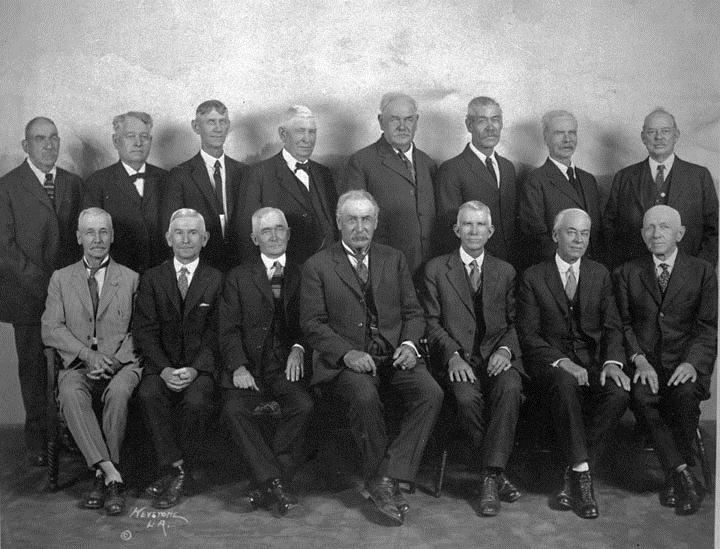 |
|
| (1926)* - Here are some of the veteran employees of the Department. In the front row are: (left to right) J. W. Bullas, George Read, Fred Fischer, William Mulholland, Thomas Brooks, L. M. Anderson, George T. Gilmore; (standing) D. Ghiotto, John Kearney, Frank E. Bell, F. R. Cady, John Herrnberger, E. R. Flores, James Moore, Arthur Beardsley. |
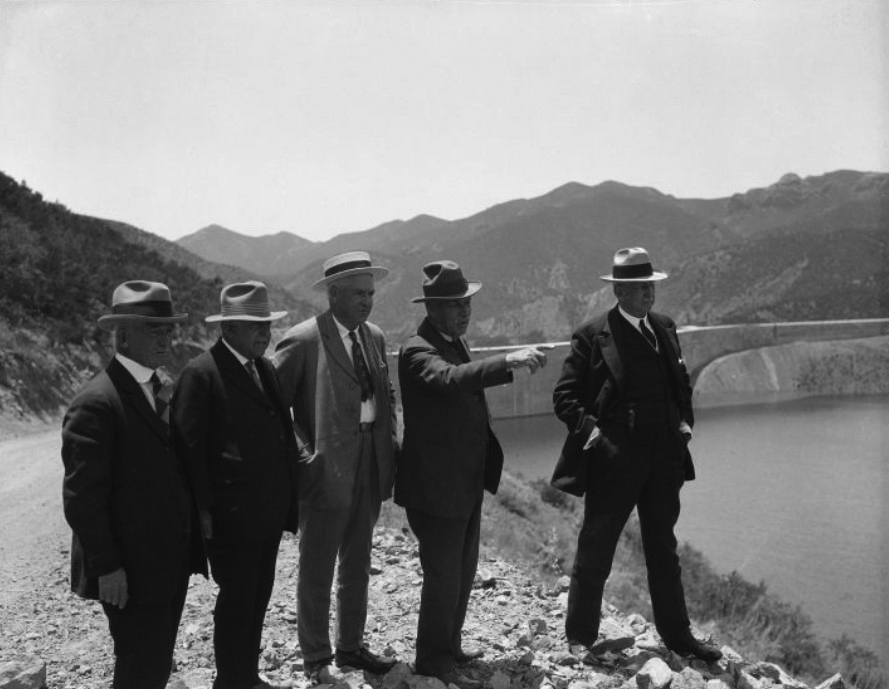 |
|
| (1928)^^ - William Mulholland, Superintendent of the Bureau of Water Works and Supply of Los Angeles, pointing towards something in the distance. Mulholland is with 4 other men on the east bank of the St. Francis Reservoir with the top of the St. Francis Dam visible behind them. |
Historical Notes From left to right can be seen Fred Fischer, R. del Valle, ???, William Mulholland and John R. Haynes. |
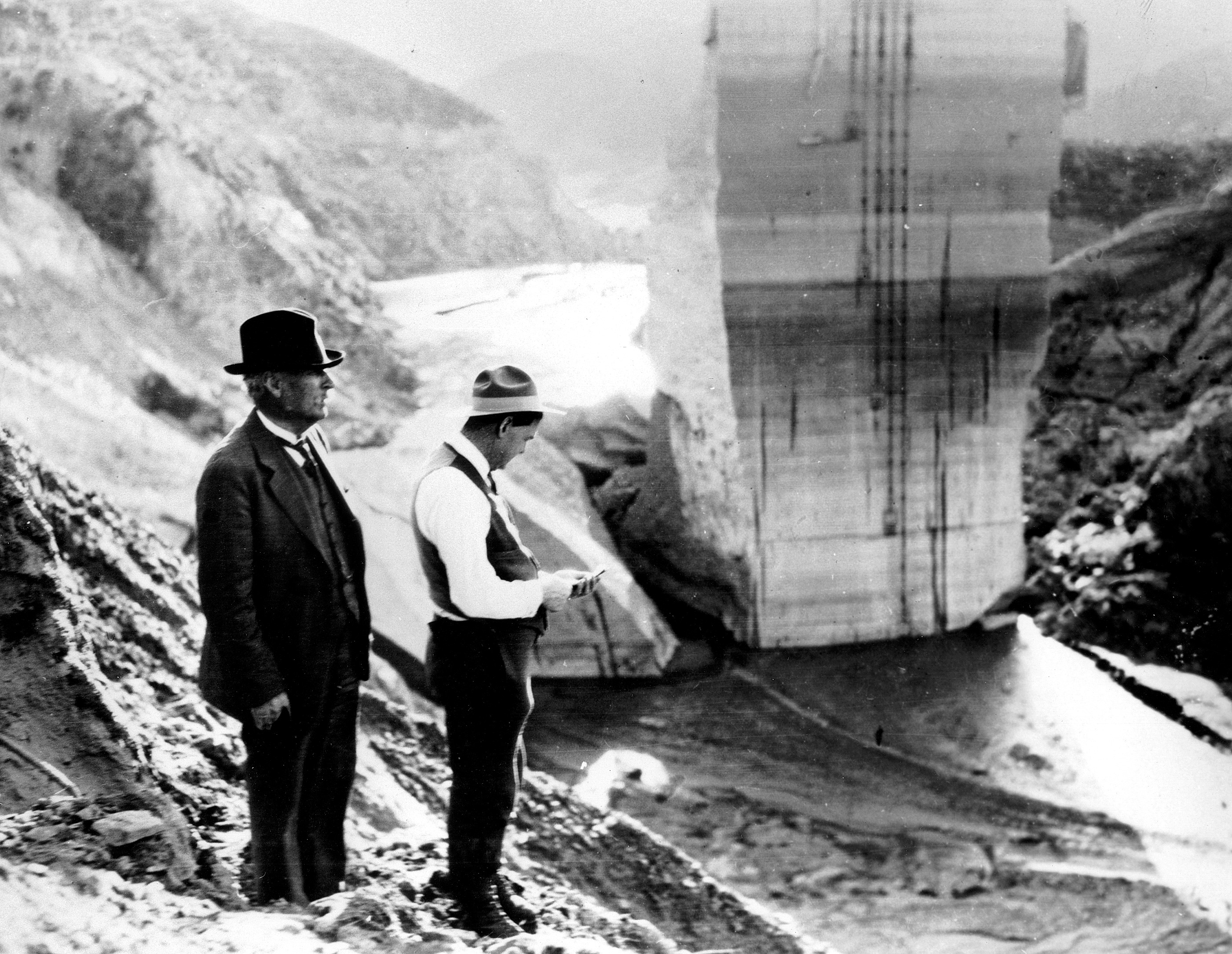 |
|
| (1928) – William Mulholland and H. Van Norman stand on the hillside overlooking St. Francis Dam ruins shortly after it failed (Click HERE to see more in the St. Francis Dam Disaster Section). |
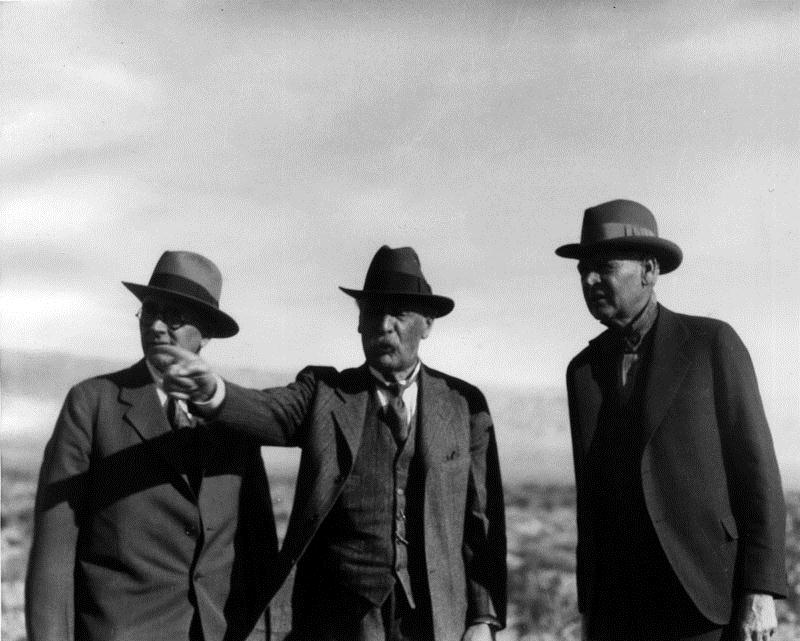 |
|
| (1931) - Three leaders in community planning that brought Colorado River water to Southern California. On a desert survey trip at the start of the huge aqueduct project in 1931 were (left to right) F. E. Weymouth, who built the aqueduct; William Mulholland, who conceived it; and W. P. Whitsett, first chairman of the Metropolitan Water District of Southern California. Photo courtesy of the Metropolitan Water District of Southern California. |
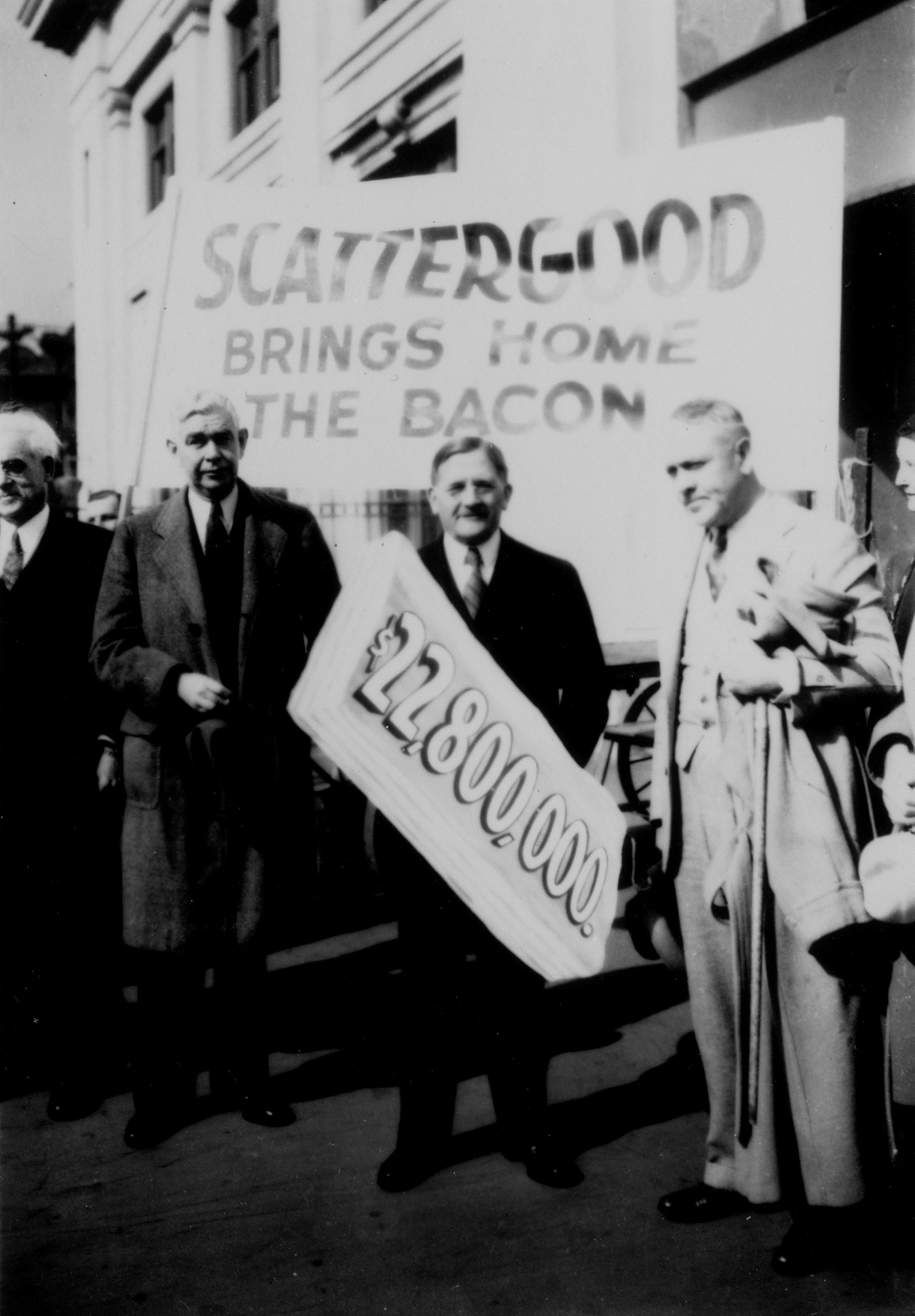 |
(1933)* - Scattergood 'Brings Home the Bacon'
In 1933 Ezra Scattergood travelled to Washington to borrow money for the construction of the Boulder Dam-LA Transmission Line. He was successful in obtaining a 10-year federal loan for $22,799,000. This enabled The Bureau of Power and Light to construct the historic 266 mile transmission line that brought Boulder Dam power to Los Angeles. (One year later, LA voters approved a bond measure to refinance the original 10-year loan to a 40-year loan.)
|
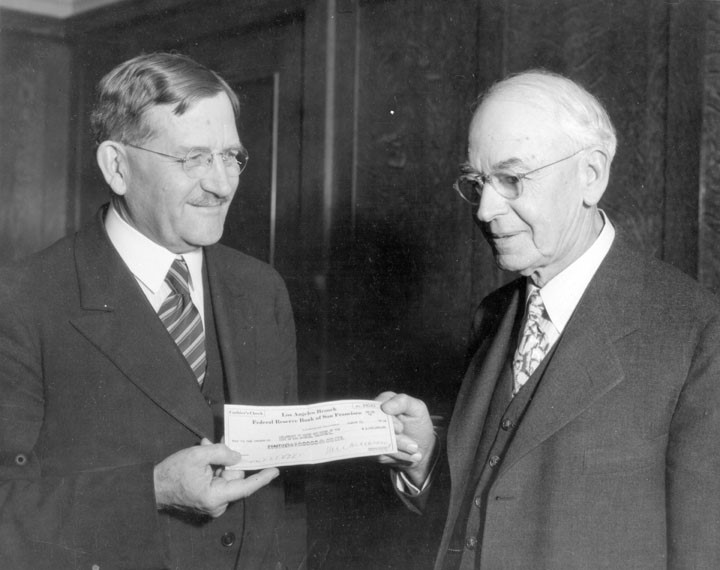 |
|
| (1930s)* - Mr. Scattergood (left) hands bond check to Lawrence M. Anderson, comptroller at Department of Water and Power. |
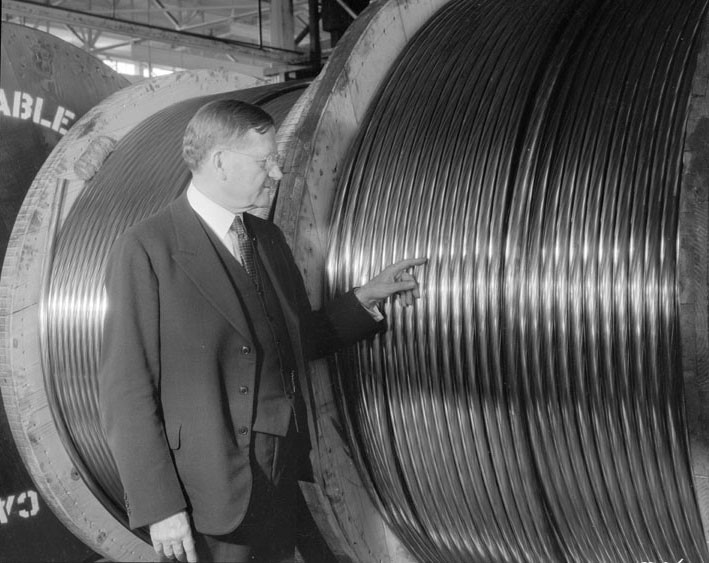 |
|
| (ca. 1933)* - E. F. Scattergood viewing the manufacturing of cable for the Boulder Line. |
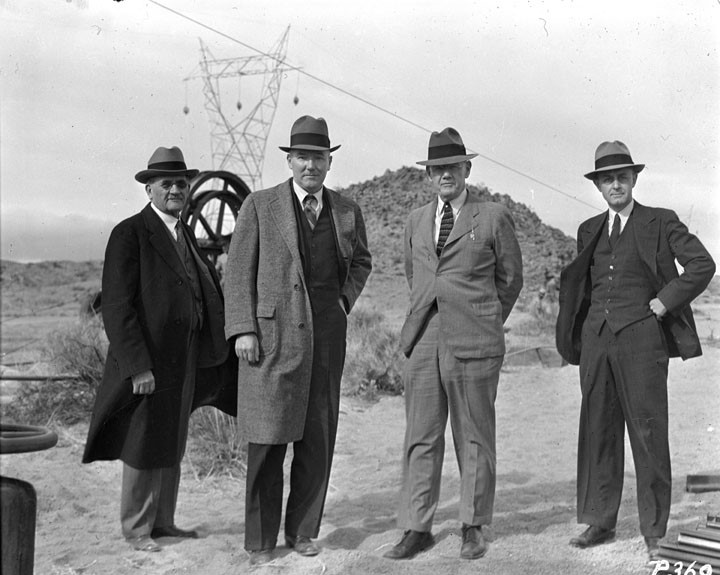 |
|
| (ca. 1934)* - Taken during construction of Boulder line in the mid 1930's - left to right: E. F. Scattergood, ?, ?, Clyde Erett. |
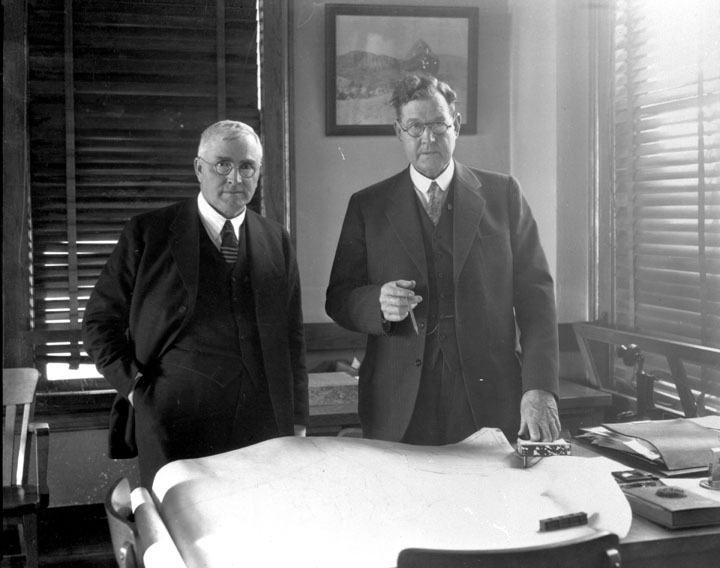 |
|
| (ca. 1930s)* - View showing Frank Weymouth and H. A. Van Norman in front of what appears to be engineering plans. |
Historical Notes In 1907 H. A. Van Norman entered the service of the city of Los Angeles and during the construction of the Owens River Aqueduct was divisional superintendent in charge of the construction of two divisions along the line of the great water carrier. Following the completion of the aqueduct Van Norman became aqueduct engineer in charge of operation and maintenance of the entire line from its intake in Owens Valley to Los Angeles. In 1924 Van Norman was “borrowed” from the water bureau by the Board of Public Works and was made engineer in charge of the construction of the new Los Angeles out-fall sewer line. A board of eastern engineers had estimated that this work would cost approximately twelve million dollars. Mr. Van Norman completed the construction of the sewer line at a cost of approximately seven million dollars, thereby saving five million dollars out of the original estimate. In 1926 Van Norman was recalled to the water bureau and made assistant chief engineer and general manager to William Mulholland. In that official capacity he was active with Mulholland during in engineering and survey work connected with the Colorado River Aqueduct. On the retirement of William Mulholland, December 1, 1928, Van Norman was made chief engineer and general manager of the Municipal Water Bureau. In 1937, the Board of Water and Power Commissioners consolidated the water and electric organizations of the department of water and power by eliminating the Bureau of Water Works and Supply and the Bureau of Power and Light and unifying the functions of these two bureaus under one management. Mr. Van Norman was appointed chief engineer and general manager of the Department of Water and Power. E. F. Scattergood was appointed chief electrical engineer of the department, and Frank E. Weymouth was appointed chief hydraulic engineer of the department.*^ |
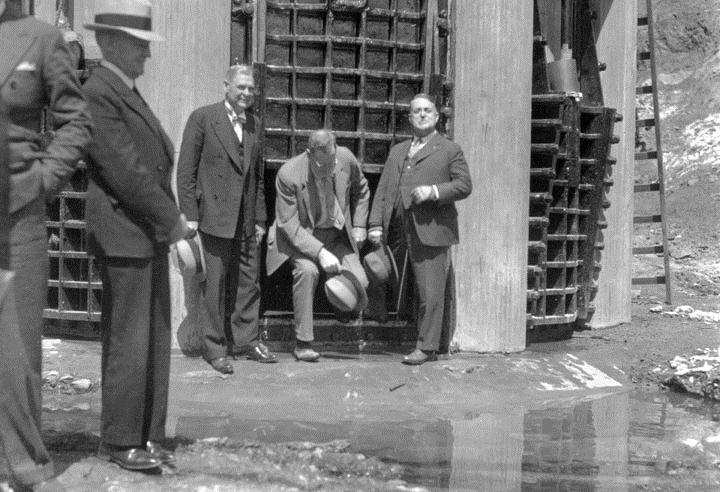 |
|
| (1934)* - Dedication of Bouquet Reservoir - left to right: A. J. Mullen, William P. Whitsett, H. A. Van Norman and Mayor Shaw. |
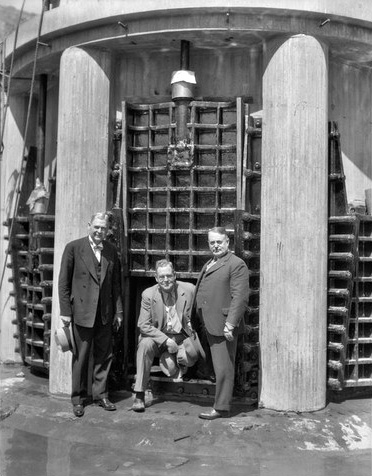 |
(1934)^^ - Dedication of the Boquet Canyon Reservoir with (L to R): William P. Whitsett, H. A. Van Norman and Mayor Frank Shaw. Whitsett, W. P. (William Paul), -- 1875-1965 Shaw, Frank L., -- 1877-1958 Van Norman, H. A. -- (Harvey Arthur), -- 1878-1954 |
|
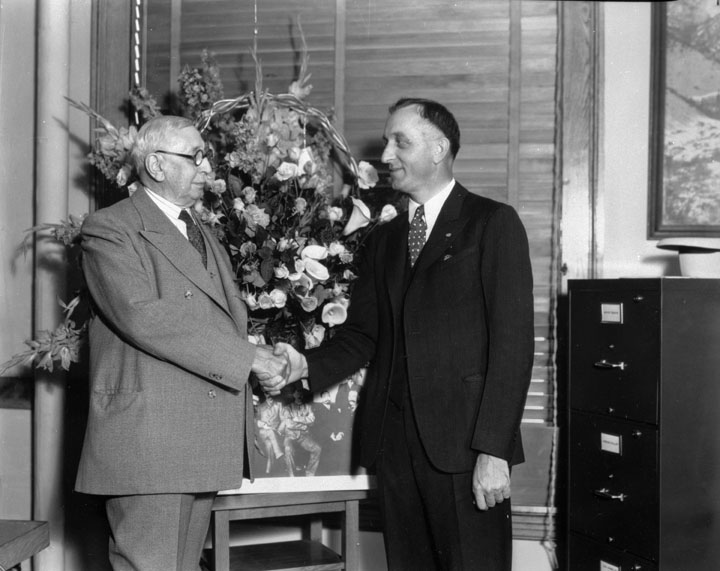 |
|
| (1933)* - Dr. John Randolph Haynes, vice-president Board of Water and Power Commissioners (left) being congratulated by President John W. Baumgartner on his eightieth birthday, June 13, 1933. |
LADWP Historic ArchiveDr. Haynes has served on the Board of Water and Power Commissioners since 1921. He held the office of president for a term and is now vice-president. He has rounded out a remarkable career of service to his fellow men. For 46 years he has lived in Los Angeles and conducted himself so as to merit the Biblical praise, “well done, thou good and faithful servant.” |
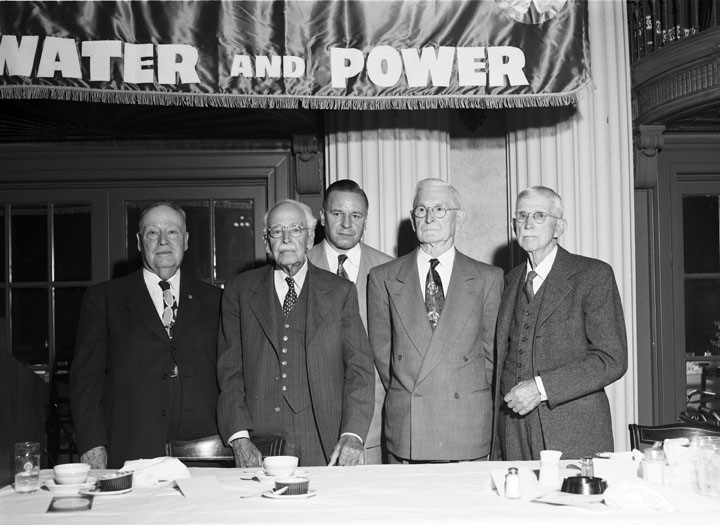 |
|
| (1952)* - At the Department of Water and Power’s 50th Anniversary Celebration are four of its oldest retirees, with W. S. Peterson – left to right: J. P. Vroman, L. M. Anderson, George Reed and Thomas Brooks. |
LADWP Historic ArchiveGala Events Herald Golden Anniversary Civic groups, schools, churches and prominent citizens joined in the city-wide observance of Water and Power Week, February 3-9, 1952, marking the Department’s fifteenth anniversary. The Mayor said, in part: “In the light of experience, now everyone must realize how much the City of Los Angeles owes to this Department of Water and Power. It has made possible a great city. The population, the business development, the industrial growth, could not have taken place otherwise. The people of Los Angeles may well be proud of their Department of Water and Power. It is their business. The benefits of its operation is the public benefit. Dividends are returned through reasonable rates and excellent and unfailing service. But all of this would not have been possible had it not been for men of vision, those who could look far ahead, decades beyond the next election, and picture in their minds a great city of the future. The important, the significant fact, about the long range planning of our Department of Water and Power is that when the planning was done it was put into action. It took definite, concrete shape. Something was created. I feel that this department should be an inspiration to all of us.” Duncan Shaw, president of the Board of Water and Power Commission, and other of the speakers, paid warm tribute to Department employees: “I personally am proud to be identified with an organization which conducts its operations with efficiency and serves well the citizens of Los Angeles….The Department has a very valuable asset which cannot be shown on a balance sheet. I refer to the loyal hardworking and efficient employees who number today more than 10,000. Time is too limited to permit more than an expression of sincere thanks to these people. We all are aware that success or failure of any business enterprise rests largely on the shoulders of management and the employees.” General Manager Samuel B. Morris said, in part: “Plenty of water and power at low rates and always on time have brought this growth from a community of a little over 100,000 fifty years ago. Looking ahead, we can expect more and more people to continue to come to our city and we in the Department are making certain that there shall always be adequate water and power.” Mr. Morris, in his remarks paid special honor to four old-time employees who were employed by the Los Angeles City Water Company before its properties were taken over by the City in 1902. These four senior employees, George Read, James P. Vroman, L. M. Anderson and Thomas Brooks, were presented with scrolls and Mr. Morris said: “Gentlemen, on this the fiftieth anniversary of the Department of Water and Power, it is with a deep sense of gratitude that the citizens of Los Angeles and the personnel of this Department honor you and, through you, all of the 30 employees of the first Water Department. I am told that your combined ages total some 331 years, and your combined service to the water system of both the private company and the City of Los Angeles totals 194 years! In appreciation for these many years of outstanding service, on behalf of the Board of Water and Power Commissioners and the Department of Water and Power, I have the privilege to present to you these certificates of honor.” *^ |
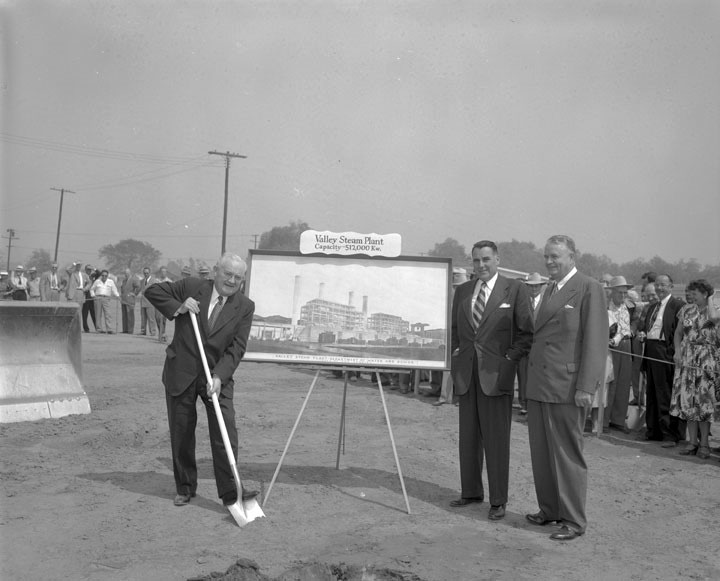 |
|
| (1951)* - Ground breaking ceremonies at Valley Steam Plant. Left to Right: Mayor Fletcher Bowron, Duncan Shaw, president of the Board of Water and Power Commissioners; and General Manager Samuel B. Morris. |
Historical Notes On September 6, 1951, construction was officially started on the Department’s new $69,000,000 Valley Steam Plant when three men, Mayor Fletcher Bowron, Duncan Shaw, President of the Board of Water and Power Commissioners, and Samuel B. Morris, General Manager and Chief Engineer, participated in the historic groundbreaking ceremonies.*^ |
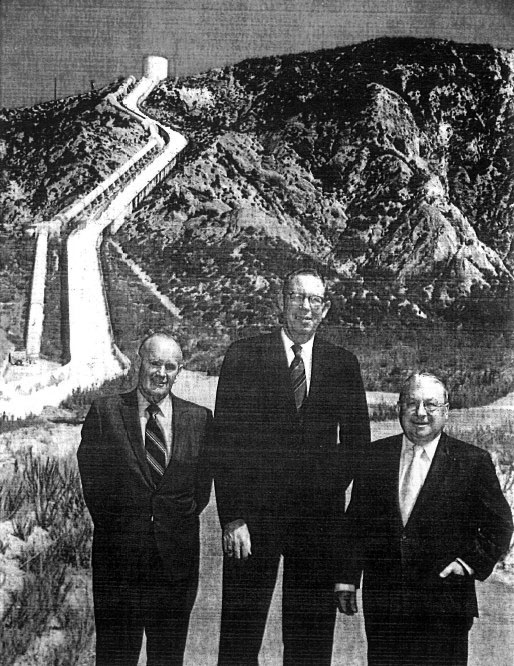 |
||
| (ca. 1970)^ - John G. Cowan, Assistant General Manager and Chief Engineer; Robert V. Phillips, Chief Engineer of Water Works and Assistant General Manager; and Edgar L. Kanouse, General Manager and Chief Engineer (l to r) are shown below the Cascades of the Second Aqueduct, completed in 1970. |
LADWP General Managers Timeline (1925 - 2019)
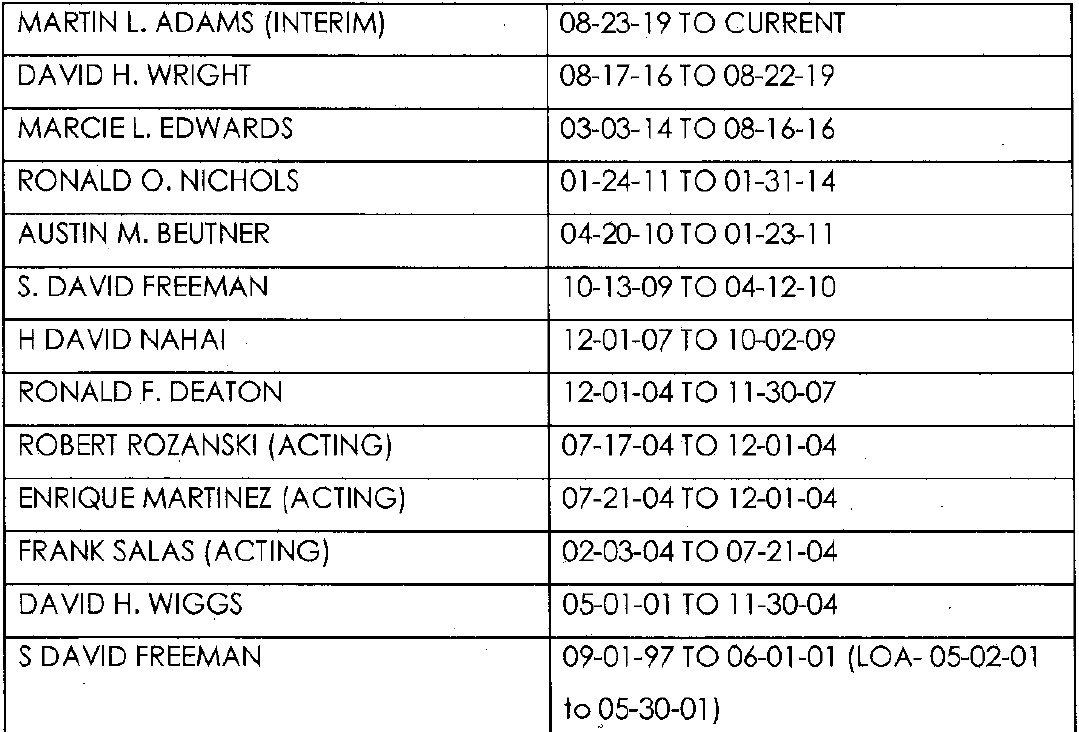 |
|
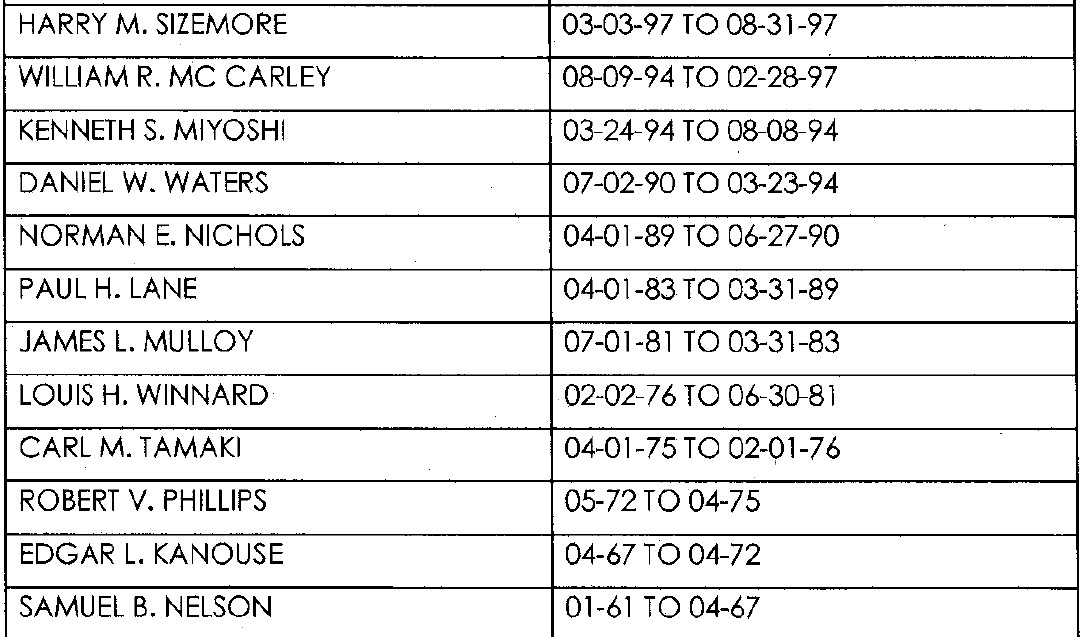 |
|
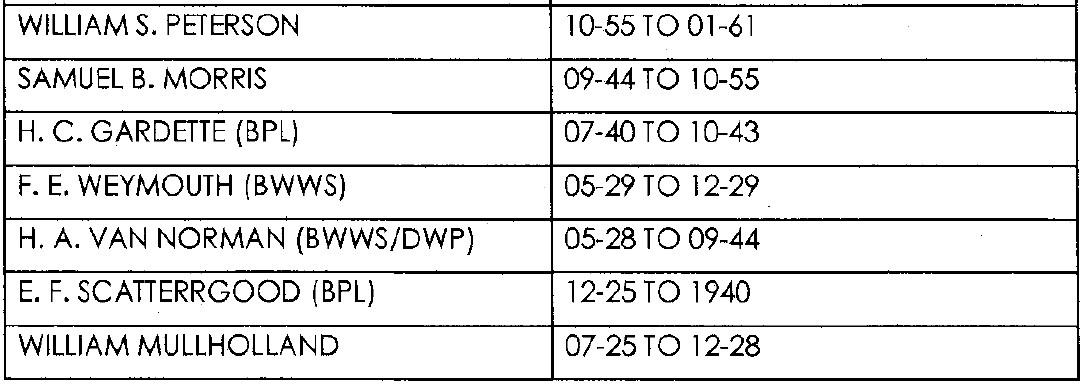 |
Early Los Angeles Mayors (1848 - 1929)
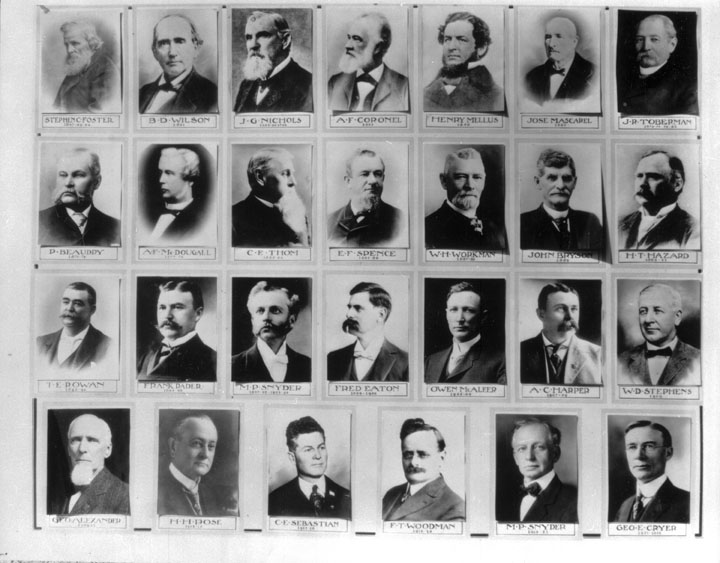 |
|
1st row Stephen C. Foster was post statehood mayor of Los Angeles from 1848-1850. He also serviced from May 4, 1854 to January 13, 1855, and January 25, 1855 to May 9, 1855, and May 7, 1856 to September 22, 1856. Benjamin D. Wilson was second mayor of Los Angeles from May 7, 1851 to May 4, 1852. John G. Nichols was third mayor of Los Angeles from May 4, 1852 to May 3, 1853. Antonio F. Coronel was fourth mayor of Los Angeles from May 3, 1853 to May 4, 1854. Henry Mellus was eighth mayor of Los Angeles from May 9, 1860 to December 26, 1860. He died in office in 1860. Joseph Mascarel was the ninth mayor of Los Angeles from May 5, 1865 to May 10, 1866. James R. Toberman was the twelfth mayor of Los Angeles from December 5, 1872 to December 18, 1874. He served two terms in office. Prudent Beaudry was the thirteenth mayor of Los Angeles from December 18, 1874 to December 8, 1876. He served two terms in office. Frederick A. MacDougal was the fourteenth mayor of Los Angeles from December 8, 1876 to November 16, 1878. He served two terms in office. Cameron E. Thom was the sixteenth mayor of Los Angeles from December 9, 1882 to December 9, 1884. He served two terms in office. Edward F. Spence was the seventeenth mayor of Los Angeles from December 9, 1884 to December 14, 1886. He served two terms in office. William H. Workman was the eighteenth mayor of Los Angeles from December 14, 1886 to December 10, 1888. He served two terms in office. John Bryson was the nineteenth mayor of Los Angeles from December 10, 1888 to February 25, 1889. He served one term in office. Henry T. Hazard was the twentieth mayor of Los Angeles from February 25, 1889 to December 5, 1892. He served two terms in office. Thomas E. Rowan was the twenty-first mayor of Los Angeles from December 12, 1892 to December 12, 1894. He served one term in office. Frank Rader was the twenty-second mayor of Los Angeles from December 12, 1894 to December 16, 1896. He served one term in office. Meredith P. Snyder was the twenty-third mayor of Los Angeles from December 16, 1896 to December 15, 1898. He served one term in office. He also served two additional terms from December 12, 1900 to December 8, 1904. Fred Eaton was the twenty-fourth mayor of Los Angeles from December 15, 1898 to December 12, 1900. He served one term in office. Owen McAleer was the twenty-fifth mayor of Los Angeles from December 8, 1904 to December 13, 1906 he served one term in office. Arthur C. Harper was the twenty-sixth mayor of Los Angeles from December 13, 1906 to March 11, 1909. He served one term in office. William D. Stephens was the twenty-seventh mayor of Los Angeles from March 15, 1909 to March 26, 1909. He served a partial term in office. George Alexander was the twenty-eighth mayor of Los Angeles from March 26, 1909 to July 1, 1913. He served two terms in office. Henry Rose was the twenty-ninth mayor of Los Angeles from July 1, 1913 to July 1, 1915. He served one term in office. Charles E. Sebastian was the thirtieth mayor of Los Angeles from July 1, 1915 to September 2, 1916. He served one term in office. Frederick T. Woodman was the thirty-first mayor of Los Angeles from September 5, 1916 to July 1, 1919. He served two terms in office. Meredith P. Snyder served one term in office from July 1, 1919 to July 1, 1921. George E. Cryer was the thirty-second mayor of Los Angeles from July 1, 1921 to July 1, 1929. He served three terms in office*^ |
* * * * * |
History of Water and Electricity in Los Angeles
More Historical Early Views
Newest Additions
Early LA Buildings and City Views
* * * * * |
References
* DWP - LA Public Library Image Archive
^* California State Library Image Archive - Joseph Lippincott Collection
^^ UCLA Library Digital Collection
*# Claremont Colleges Digital Library
< Back
Menu
- Home
- Mission
- Museum
- Mulholland Service Award
- Major Efforts
- Board Officers and Directors
- Positions on Owens Valley and the City of Los Angeles Issues
- Legislative Positions on
Water Issues
- Legislative Positions on
Energy Issues
- Recent Newsletters
- Historical Op Ed Pieces
- Membership
- Contact Us
- Search Index